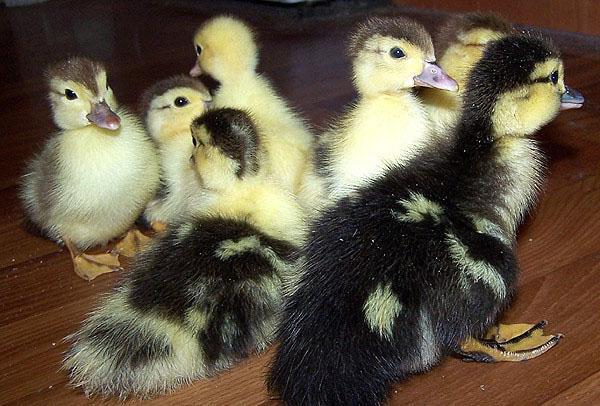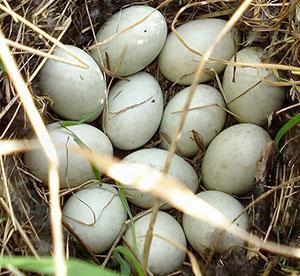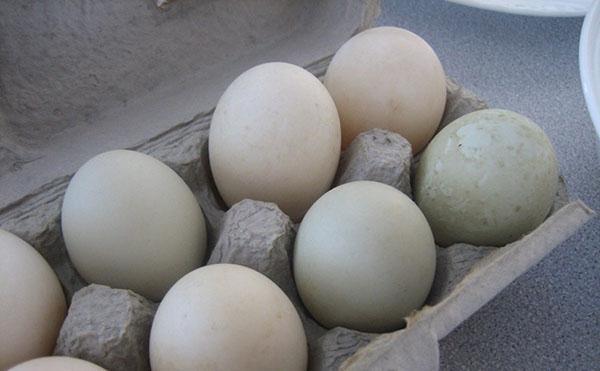We lay duck eggs in an incubator at home
 If hens sit on the clutch at different times, then artificial incubation makes it possible to simultaneously hatch a large number of even, strong ducklings. Before laying duck eggs in an incubator, at home they must be properly collected, stored and discarded. Only in this case the expended efforts will give the proper result.
If hens sit on the clutch at different times, then artificial incubation makes it possible to simultaneously hatch a large number of even, strong ducklings. Before laying duck eggs in an incubator, at home they must be properly collected, stored and discarded. Only in this case the expended efforts will give the proper result.
Read also: correct incubation of chicken eggs and temperature conditions!
Collection and storage of duck eggs for the incubator

To avoid the appearance of mold, parasites and other infections, the litter in the nests is changed every day. It is more convenient to do this in the evening, and from early in the morning, start collecting duck eggs for the incubator. If a fresh egg enters a surface inseminated by bacteria, in a humid warm environment, all pathogenic flora destructive for future chicks will penetrate through the pores in the shell.
In the warm season, when the eggs are not threatened with hypothermia and the death of embryos, they are collected every hour. But the colder it is outside and in the house, the more often the breeder should inspect the nests of layers.
Immediately after collection, the eggs are not washed and in no case cleaned by mechanical methods that can damage the integrity of the shell, but are dipped in an antiseptic solution. Until a sufficient number of eggs have been collected for hatching, they are placed on trays with the sharp end down, vertically or slightly tilted.
 Storage of duck eggs for incubation in an incubator is possible only at a temperature of 10-15 ° C and an air humidity of 75-80% for no longer than 8 days, otherwise the hatching percentage will significantly decrease, and the resulting chicks will be weak. See: duck mulardy photo!
Storage of duck eggs for incubation in an incubator is possible only at a temperature of 10-15 ° C and an air humidity of 75-80% for no longer than 8 days, otherwise the hatching percentage will significantly decrease, and the resulting chicks will be weak. See: duck mulardy photo!
Selection of duck eggs for incubation
Only selected eggs, which can be identified by the correct shape, the absence of any growths or sagging on the shell, should enter the incubator. The duck egg should be about the same size, even and clean.
Transmission helps to confirm the correct choice. During this procedure, it is easy to identify microscopic cracks, uneven shells, discard unfertilized, old or otherwise unviable eggs, for example, with dark mold spots inside or with spilled yolk.
 In duck eggs worthy of entering the incubator at home, you can see that:
In duck eggs worthy of entering the incubator at home, you can see that:
- the yolk is located strictly in the center;
- the protein does not contain foreign inclusions and is completely transparent when translucent;
- the air chamber inside the egg is small and located exactly under or near the blunt apex.
Incubating a duck egg at home
 Duck eggs in the incubator are laid out with the pointed end down with a slight slope. If musk ducks are to be hatched, then their egg is placed horizontally on the tray. This will ensure the fastest development of the embryo and a higher percentage of hatching.
Duck eggs in the incubator are laid out with the pointed end down with a slight slope. If musk ducks are to be hatched, then their egg is placed horizontally on the tray. This will ensure the fastest development of the embryo and a higher percentage of hatching.
In an incubator where the trays can be rotated, it is better to pre-fix the eggs in containers.
All the measures necessary for hatching duck eggs in an incubator at home are shown in the table. It is easy to see that the temperature gradually decreases throughout the incubation period, while the humidity, on the contrary, increases.
This is due to the fact that as the embryo develops in the middle of the cycle, the egg itself begins to release heat into the atmosphere. In addition to maintaining the optimum temperature for duck eggs, the humidity level is monitored in the incubator.
The closer the chicks hatch, the greater the evaporation of moisture that penetrates through the pores of the shell to the outside. An uncontrolled process threatens the death of the embryo, and you can prevent it and cool the eggs with the help of regular spraying.
For irrigation, use pure water or a weak solution of potassium permanganate, which is sprayed from the fifth day of incubation twice a day during airing.

- from the 1st to the 14th day - 37.5–38.0 ° C;
- from the 14th to the 21st day - 38.0–38.5 ° C;
- from the 21st to the 26th day - 38.5–39.0 ° C.
Eggs are constantly inverted on a continuous basis until being transferred to the hatcher trays. This should be done 4 to 12 times a day, depending on the design of the incubator and the incubation period.
 To control the state of eggs in an incubator for hatching ducklings, at home on the 8th, 13th and 25th day, they are exposed to x-ray. Eggs, inside of which there are no signs of development, whether there are all symptoms of spoilage, are removed.
To control the state of eggs in an incubator for hatching ducklings, at home on the 8th, 13th and 25th day, they are exposed to x-ray. Eggs, inside of which there are no signs of development, whether there are all symptoms of spoilage, are removed.
If duck eggs are loaded into the incubator, then the poultry farmer needs to be aware that incubation will take a little longer. Usually, ducklings appear in the incubator after 33–36 days.
The table shows the entire cycle of care from laying an egg to the moment the chicks of the muscovy are hatched.
Breeding ducklings in an incubator at home
At the first sign of pecking, duck eggs are transferred to hatcher trays. Here they are laid out horizontally. The first chicks hatch on the 26th day, the last ones most often hatch by the beginning of the 28th day.
 When the hatching of ducklings begins in the incubator at home, just like when hatching goslings, it is important to ensure good ventilation and adherence to temperature conditions. The emerging chicks are transferred to dry ventilated rooms with a temperature of about 20-24 ° C. Here the ducklings have to dry out. After hatching is complete, the bird is sorted and, if necessary, discarded.
When the hatching of ducklings begins in the incubator at home, just like when hatching goslings, it is important to ensure good ventilation and adherence to temperature conditions. The emerging chicks are transferred to dry ventilated rooms with a temperature of about 20-24 ° C. Here the ducklings have to dry out. After hatching is complete, the bird is sorted and, if necessary, discarded.
The weight of a duckling suitable for further keeping and growing depends on the size of the egg, and most often it ranges from 55–70 grams. At one day of age, the ducklings from the incubator stand well on their feet, are mobile, have an excellent appetite and are covered with even high-quality down. On examination, attention is paid to the cleanliness of the eyes and beak, the umbilical cord that has fallen off and successfully healed, and the tight, not hanging belly.
On this topic: Indoor women - breeding, maintenance and care at home in winter!
alas, for incubation, the egg is not washed .... there will be a violation of air exchange through the shell
Before incubation, duck eggs are brought into the room where the incubator is located. After 3-4 hours the eggs are washed with a light manganese solution without using hard rags and sponges. Then wipe it with a soft towel and put the markings, and then put it in the incubator. Dirty eggs heat up unevenly, and when they are subsequently wetted in the incubator, they will simply be dirty. In addition, this approach will help prevent the death and disease of the brood. If you observe the duck, you will notice that the female wets the eggs and, constantly turning them, removes the top film from the shell.
2 years in a row geese rushed from the new year to the summer and now for some reason there are no eggs, although already in March it is interesting to know why
Show me a video where a duck can rub eggs with a light solution of potassium permanganate. Breeds smart and goose eggs, and never washed or processed anything. So is the chicken. The only thing I did was try to lay a more or less clean egg and, before laying, disinfected it with an ultraviolet lamp for 2-3 minutes with azone.
In nature, ducks get out of the nest and swim. Then they lay down on the eggs, moisten them and turn them over. At the same time, claws scratch the shell and it becomes thinner. We sometimes pick up dirty eggs. Therefore, before laying in the incubator, we rinse in a weak solution of potassium permanganate. You are using a different disinfection method.